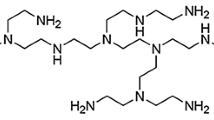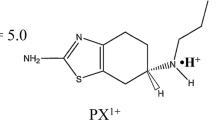Abstract
Purpose
To demonstrate the transdermal iontophoretic delivery of a small (12.4 kDa) protein across intact skin.
Materials and Methods
The iontophoretic transport of Cytochrome c (Cyt c) across porcine ear skin in vitro was investigated and quantified by HPLC. The effect of protein concentration (0.35 and 0.7 mM), current density (0.15, 0.3 or 0.5 mA.cm−2 applied for 8 h) and competing ions was evaluated. Co-iontophoresis of acetaminophen was employed to quantify the respective contributions of electromigration (EM) and electroosmosis (EO).
Results
The data confirmed the transdermal iontophoretic delivery of intact Cyt c. Electromigration was the principal transport mechanism, accounting for ∼90% of delivery; correlation between EM flux and electrophoretic mobility was consistent with earlier results using small molecules. Modest EO inhibition was observed at 0.5 mA.cm−2. Cumulative permeation at 0.3 and 0.5 mA.cm−2 was significantly greater than that at 0.15 mA.cm−2; fluxes using 0.35 and 0.7 mM Cyt c in the absence of competing ions (J tot = 182.8 ± 56.8 and 265.2 ± 149.1 μg.cm−2.h−1, respectively) were statistically equivalent. Formulation in PBS (pH 8.2) confirmed the impact of competing charge carriers; inclusion of ∼170 mM Na+ resulted in a 3.9-fold decrease in total flux.
Conclusions
Significant amounts (∼0.9 mg.cm−2 over 8 h) of Cyt c were delivered non-invasively across intact skin by transdermal electrotransport.








Similar content being viewed by others
Abbreviations
- ACE:
-
acetaminophen
- Cyt c:
-
cytochrome c
- CZE:
-
capillary zone electrophoresis
- EM:
-
electromigration
- EO:
-
electroosmosis
- JEM, Cyt c :
-
flux due to electromigration of Cyt c
- JEO, Cyt c :
-
flux due to electroosmosis of Cyt c
- Jtot, Cyt c :
-
total steady-state flux of Cyt c
- Vw :
-
convective solvent flow
References
Y. B. Schuetz, P-A. Carrupt, A. Naik, R. H. Guy, and Y. N. Kalia. Structure-permeation relationships for the non-invasive transdermal delivery of cationic peptides by iontophoresis. Eur. J. Pharm. Sci. 29:53–59 (2006).
R. R. Burnette. Iontophoresis. In J. Hadgraft and R. Guy (eds.), Transdermal Drug Delivery, Marcel Dekker, New York, 1989, pp. 247–288.
Y. N. Kalia, A. Naik, J. Garrison, and R. H. Guy. Iontophoretic drug delivery. Adv. Drug Deliv. Rev. 56:619–658 (2004).
M. C. Heit, P. L. Williams, F. L. Jayes, S. K. Chang, and J. E. Riviere. Transdermal iontophoretic peptide delivery: in vitro and in vivo studies with luteinizing hormone releasing hormone. J. Pharm. Sci. 82:240–243 (1993).
J. Raiman, M. Koljonen, K. Huikko, R. Kostiainen, and J. Hirvonen. Delivery and stability of LHRH and Nafarelin in human skin: the effect of constant/pulsed iontophoresis. Eur. J. Pharm. Sci. 21:371–377 (2004).
P. Santi, N. M. Volpato, R. Bettini, P. L. Catellani, G. Massimo, and P. Colombo. Transdermal iontophoresis of salmon calcitonin can reproduce the hypocalcemic effect of intravenous administration. Farmaco 52:445–448 (1997).
A. Chaturvedula, D. P. Joshi, C. Anderson, R. L. Morris, W. L. Sembrowich, and A. K. Banga. In vivo iontophoretic delivery and pharmacokinetics of salmon calcitonin. Int. J. Pharm. 297:190–196 (2005).
S. Kumar, H. Char, S. Patel, D. Piemontese, A. W. Malick, K. Iqbal, E. Neugroschel, and Ch. R. Behl. Effect of iontophoresis on in vitro skin permeation of an analog of growth hormone releasing factor in the hairless guinea pig model. J. Pharm. Sci. 81:635–639 (1992).
Y. Suzuki, K. Iga, Sh. Yanai, Y. Matsumoto, M. Kawase, T. Fukuda, H. Adachi, N. Higo, and Y. Ogawa. Iontophoretic pulsatile transdermal delivery of human parathyroid hormone (1–34). J. Pharm. Pharmacol. 53:1227–1234 (2001).
L. Langkjaer, J. Brange, G. M. Grodsky, and R. H. Guy. Iontophoresis of monomeric insulin analogs in vitro: effects of insulin charge and skin pretreatment. J. Control. Release 51:47–56 (1998).
O. Pillai and R. Panchagnula. Transdermal iontophoresis of insulin: V. Effect of terpenes. J. Control. Release 88:287–296 (2003).
N. G. Turner, L. Ferry, M. Price, C. Cullander, and R. H. Guy. Iontophoresis of poly-L-lysines: the role of molecular weight? Pharm. Res. 14:1322–1331 (1997).
R. Haak and S. K. Gupta. Pulsatile drug delivery from electrotransport therapeutic systems. In R. Gurny, H. E. Junginger, and N. A. Peppas (eds.), Pulsatile Drug Delivery—Current Applications and Future Trends, Wiss, Verl.-Ges., Stuttgart, 1993, pp. 99–112.
P. Green. Iontophoretic delivery of peptide drugs. J. Control. Release 41:33–48 (1996).
M. B. Delgado-Charro and R. H. Guy. Iontophoresis of peptides. In Bret Berner and S. M. Dinh (eds.), Electronically Controlled Drug Delivery, Vol. 1, CRS, New York, 1998, pp. 129–157.
R. H. Guy, Y. N. Kalia, M. B. Delgado-Charro, V. Merino, A. López, and D. Marro. Iontophoresis: electrorepulsion and electroosmosis. J. Control. Release 64:129–132 (2000).
N. Abla, A. Naik, R. H. Guy, and Y. N. Kalia. Effect of charge and molecular weight on transdermal peptide delivery by iontophoresis. Pharm. Res. 22:2069–2078 (2005).
N. Abla, L. Geiser, M. Mirgaldi, A. Naik, J.-L. Veuthey, R. H. Guy, and Y. N. Kalia. Capillary zone electrophoresis for the estimation of transdermal iontophoretic mobility. J. Pharm. Sci. 94:2667–2675 (2005).
G. W. Bushnell, G. V. Louie, and G. D. Brayer. High-resolution three-dimensional structure of horse heart cytochrome c. J. Mol. Biol. 214:585–595 (1990).
Y. B. Schuetz, A. Naik, R. H. Guy, E. Vuaridel, and Y. N. Kalia. Transdermal iontophoretic delivery of vapreotide acetate across porcine skin in vitro. Pharm. Res. 22:1305–1312 (2005).
M. J. Picklo, J. Zhang, V. Q. Nguyen, D. G. Graham, and T. J. Montine. High pressure liquid chromatography quantitation of Cytochrome c using 393 nm detection. Anal. Biochem. 276:166–170 (1999).
N. Abla, A. Naik, R. H. Guy, and Y. N. Kalia. Contributions of electromigration and electroosmosis to peptide iontophoresis across intact and impaired skin. J. Control. Release 108:319–330 (2005).
J. E. De Muth. Basic Statistics and Pharmaceutical Statistical Applications, Marcel Dekker, New York, 1999.
D. T. W. Lau, J. W. Sharkey, L. Petryk, F. A. Mancuso, Z. Yu, and F. L. S. Tse. Effect of current magnitude and drug concentration on iontophoretic delivery of octreotide acetate (Sandostatin®) in the rabbit. Pharm. Res. 11:1742–1746 (1994).
S. K. Gupta, M. Southam, G. Sathyan, and M. Klausner. Effect of current density on pharmacokinetics following continuous or intermittent input from a fentanyl electrotransport system. J. Pharm. Sci. 87:976–981 (1998).
P. Singh, S. Boniello, P. Liu, and S. Dinh. Transdermal iontophoretic delivery of methylphenidate HCl in vitro. Int. J. Pharm. 178:121–128 (1999).
Y. B. Schuetz, A. Naik, R. H. Guy, E. Vuaridel, and Y. N. Kalia. Transdermal iontophoretic delivery of triptorelin in vitro. J. Pharm. Sci. 94:2175–2182 (2005).
G. B. Kasting and J. C. Keister. Application of electrodiffusion theory for a homogeneous membrane to iontophoretic transport through skin. J. Control. Release 8:195–210 (1989).
W. H. M. Craane-van Hinsberg, L. Bax, N. H. M. Flinterman, J. Verhoef, H. E. Junginger, and H. E. Bodde. Iontophoresis of a model peptide across human skin in vitro: effects of iontophoresis protocol, pH and ionic strength on peptide flux and skin impedance. Pharm. Res. 11:1296–1300 (1994).
M. F. Lu, D. Lee, R. Carlson, G. S. Rao, H. W. Hui, L. Adjei, M. Herrin, D. Sundberg, and L. Hsu. The effects of formulation variables on iontophoretic transdermal delivery of leuprolide to humans. Drug Deliv. Ind. Pharm. 19:1557–1571 (1993).
Y. B. Schuetz, A. Naik, R. H. Guy, and Y. N. Kalia. Effect of amino acid sequence on transdermal iontophoretic peptide delivery. Eur. J. Pharm. Sci. 26:429–437 (2005).
G. H. Barlow and E. Margoliash. Electrophoretic behaviour of mammalian-type cytochromes c. J. Biol. Chem. 241:1473–1477 (1966).
J. Hirvonen and R. H. Guy. Transdermal iontophoresis: modulation of electroosmosis by polypeptide. J. Control. Release 50:283–289 (1998).
R. V. Rice, M. A. Stahmann, and R. A. Alberty. The interaction of lysine polypeptides and bovine plasma albumin. J. Biol. Chem. 209:105–115 (1954).
J. Hirvonen and R. H. Guy. Iontophoretic delivery across the skin: electroosmosis and its modulation by drug substances. Pharm. Res. 14:1258–1263 (1997).
D. Marro, Y. N. Kalia, M. B. Delgado-Charro, and R. H. Guy. Contributions of electromigration and electroosmosis to iontophoretic drug delivery. Pharm. Res. 18:1701–1708 (2001).
I. Ichinose, Y. Hashimoto, and T. Kunitake. Wrapping of bio-macromolecule (dextran, amylopectin and horse heart Cytochrome c) with ultrathin silicate layer. Chem. Lett. 33:656–657 (2004).
V. Aguilella, K. Kontturi, L. Murtomäki, and P. Ramirez. Estimation of the pore size and charge density in human cadaver skin. J. Control. Release 32:249–257 (1994).
O. D. Uitto and H. S. White. Electroosmotic pore transport in human skin. Pharm. Res. 20:646–652 (2003).
M. J. Pikal. Transport mechanisms in iontophoresis: I. A theoretical model for the effect of electroosmotic flow on flux enhancement in transdermal iontophoresis. Pharm. Res. 7:118–126 (1990).
S. B. Ruddy and B. W. Hadzija. Iontophoretic permeability of polyethylene glycols through hairless rat skin: application of hydrodynamic theory for hindered transport through liquid-filled pores. Drug Des. Discov. 8:207–224 (1992).
Acknowledgements
We would like to thank Prof. Leonardo Scapozza and Dr. Shaheen Ahmed for help with the molecular graphics representations of Cytochrome c. J. Cázares Delgadillo acknowledges support from CONACYT (Mexico).
Author information
Authors and Affiliations
Corresponding author
Rights and permissions
About this article
Cite this article
Cázares-Delgadillo, J., Naik, A., Ganem-Rondero, A. et al. Transdermal Delivery of Cytochrome C—A 12.4 kDa Protein—Across Intact Skin by Constant–Current Iontophoresis. Pharm Res 24, 1360–1368 (2007). https://doi.org/10.1007/s11095-007-9294-4
Received:
Accepted:
Published:
Issue Date:
DOI: https://doi.org/10.1007/s11095-007-9294-4




